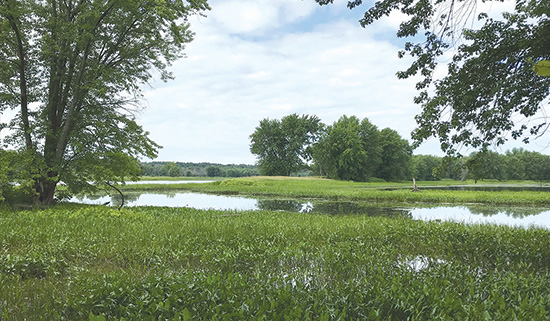What comes to mind when you hear the word "wetlands"? Maybe swamp, slough, mosquito infested, a brackish odour? While many of us think of marshland as unusable real estate, in reality, wetlands contribute critical functions to the environment. Look no further than Petrie Island, at the north end of Trim Road along the Ottawa River to illustrate.
 |
| The wetlands that surround Petrie Island contain a tremendous amount of biodiversity. PHOTO SUPPLIED |
Petrie Island is actually a group of islands that was formed by sand deposited at the close of the last ice age, about 12,000 years ago. When Hydro-Québec’s Carillon power dam opened in 1964, it raised the water levels of the Ottawa River by one to one and a half metres, which created much of today’s marshy areas and backwaters that are found at the Island.
In addition, the entire area is subject to spring flooding. The islands are designated as provincially significant wetlands, as well as a regionally significant area of natural and scientific interest (ANSI, Ontario Ministry of Natural Resources).
One of the most important contributions that wetlands make is providing a home for a wide diversity of plant and animal species, many of which depend on the water for at least part of their natural lifecycle. Just think of the variety of life forms: birds including those that nest there, or stop at Petrie Island as part of their migration; waterfowl; mammals; aquatic insects; invertebrates; amphibians; reptiles; plants and trees.
Many people visit the Island to see the painted, map and snapping turtles that nest there. Twenty-nine rare plant species, the most northerly major stand of hackberry trees in Canada and over 130 types of birds are examples of the rich biodiversity found at Petrie.
Wetlands provide a buffering effect to environmental extremes. They act as a sponge to absorb large amounts of water during flooding, and then gradually release water during periods of drought. The plant life, like willows and dogwoods, prevent erosion of the shoreline and reduce the impact of waves and currents. As well, wetlands often play an important role in carbon storage and in the hydrological cycles of nature. Protecting wetlands has become an important plank in addressing climate change.
One of the most important functions of wetlands is their ability to filter sediments and pollutants from the water. Sometimes wetlands are referred to as the earth’s kidneys as, just like humanc kidneys filter waste from the blood, wetlands remove harmful bacteria, nitrogen, heavy metals and chemicals from the water.
The Ottawa River has a sad history of pollutants from lumber, agriculture and municipal waste water so any assistance from natural wetlands helps.
This is a good place to remind ourselves how much Petrie Island, like other wetlands, contributes to our own enjoyment. It is an exceptional place for water sports, fishing, bird watching, canoeing, kayaking and hiking.
Many people visit just to enjoy the peace and relaxation that comes with spending time in nature.
With the COVID-19 pandemic causing many of us increased stress, a trip to Petrie might be just the answer. And did we mention that Petrie affords spectacular views of both the sunrise and the sunset?
The Friends of Petrie Island, a volunteer organization that works to preserve the ecology of the Island, offers interpretative signage, naturalist education and maintains a picnic area and easy walking trails to encourage people to get to know this valuable local wetland. Check out their web site at petrieisland.org to find out more and get involved.
Next time you hear the word “wetlands” maybe now the words that will come to mind are fascinating, essential, and precious..
(This
story was made possible thanks to the generous support of
our local business partners.)
